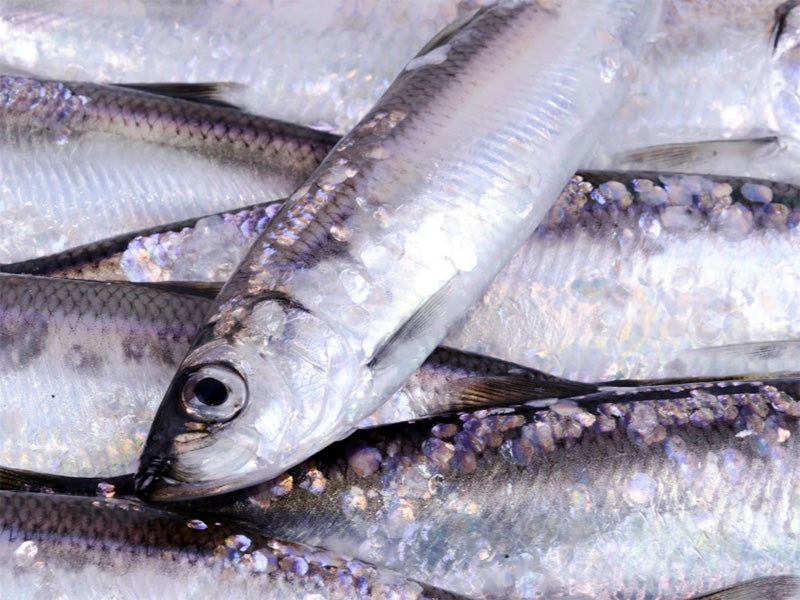Energy Bars of the Sea
Everything in the ocean is food to something else, a food web comprising many food chains. Earthjustice attorneys are stepping in to help stop the plunder of the ocean’s larders.

Perhaps you’ve seen the ocean feeding frenzy—one of nature’s most dramatic spectacles: birds diving into water that boils with slashing fish, sharks and sea lions; whales crashing out of the depths with mouths agape.
At the heart of this madness—the cause of it all—are bite-size forage fish like herring, mackerel, menhaden, or sardines. Packed with solar energy they absorbed from eating plankton, the forage fish are delicious to just about everything bigger than themselves. As Earthjustice attorney Andrea Treece describes, they are “wheaties for whales and powerbars for pinnipeds (seals and sea lions).”
They are the ocean’s larder and, says Treece, “Salmon, tuna, swordfish, halibut and even humpback whales need a fully stocked pantry to survive.”
Problem is, these same forage fish are being overfished to feed land-based creatures, bringing Earthjustice into the fight to keep the ocean well-stocked.
To understand the role forage fish play, a little ocean ecology is helpful.
Everything in the ocean is food to something else, a food web comprising many food chains. The position a species occupies in the chain is the “trophic level.”
Near the lowest trophic level of the food chain are microscopic plants and animals like plankton (vegetation and tiny creatures that float). Mid-trophic species include forage fish that feast on plankton. Higher up on the food chain, predator species such as cod, tuna, salmon, sea lions and whales gobble up forage fish to survive.
But, this chain of life is being destroyed by industrial-scale fishing boats that—for lack of regulations—are stripping the ocean of mid-level trophic species.
In the Atlantic, herring , mackerel and menhaden are the common forage fish. They are the primary food for such commercially valuable fish as cod, sport fish like striped bass and tuna, and countless birds and marine mammals. Eastern forage fish are processed to make fishmeal for chicken and fish farms, reduced for fish oil, and used as bait.
Packed with solar energy absorbed from eating plankton, forage fish are delicious to just about everything bigger than themselves.
“Among fishermen like our clients who recognize the importance of restoring all fish stocks and take a long term view, there’s a much greater understanding of the need to protect these less charismatic species that are critical to ocean health,” explains Earthjustice attorney Erica Fuller .
On the West Coast, sardine, anchovy and mackerel populate the California Current ecosystem. They are harvested from Mexico to Canada. But widespread as they are, the collapse of the sardine fishery in California in the 1950s proved that forage fish are not endlessly abundant. Today, Cannery Row in Monterey is a tourist destination, not a fishing village.
[Forage fish are] wheaties for whales and powerbars for pinnipeds … Salmon, tuna, swordfish, halibut and even humpback whales need a fully stocked pantry to survive.
– Attorney Andrea Treece
Most fisheries management is based on the notion of maximum sustained yield (how much of a species can be harvested each year without the population collapsing). That system is no longer working.
To create a more sustainable ocean food web we need to get away from maximum sustained yields and adopt ecosystem-based management. Ecosystem-based management aims to understand and protect the ocean’s food web as a complete system.
Recent data confirm that leaving forage fish in the ocean benefits not only the ecosystem, but also generates greater economic returns.
A new report, Little Fish, Big Impact by the Lenfest Forage Fish Task Force, found that current management practices do not consider the natural population swings of forage fish due to ocean conditions. They also ignore how many forage fish should be left in the sea for marine mammals, seabirds, tuna, salmon and cod.
The task force recommends cutting catch rates by 50 percent in many ecosystems and doubling the minimum biomass left in the sea to protect all those species higher up the food chain.
Earthjustice helped win two important victories in June of 2012 when both the Northeast and Mid-Atlantic Fisheries Councils recommended new rules that will put federally approved observers on every industrial trawler and require that the catch be brought on board vessels for monitoring, and weighed. The goal is to establish a cap on how many depleted forage fish can be caught as “bycatch” in this fishery.
With a more balanced set of rules that recognize predator needs, we can protect the economic vitality of our seas into the future.
Written by Brian Smith.
First published in the Earthjustice Quarterly Magazine , Fall 2012 issue.